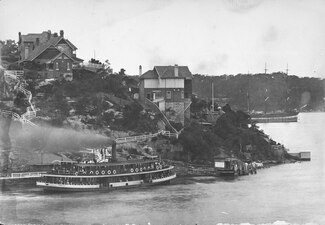 Kummulla in Mosman Bay | |
| History | |
|---|---|
| Name | Kummulla |
| Operator | Sydney Ferries Limited |
| Builder | Dunn Brothers, Berrys Bay |
| Launched | 1902 |
| Completed | 1903 |
| Out of service | 1934 |
| Fate | Scrapped 1939 |
| General characteristics | |
| Tonnage | 168 |
| Length | 36.3 m |
| Beam | 7.6 m |
| Speed | 12 knots |
| Capacity | 795 |
Kummulla was a "K-class" ferry on Sydney Harbour. Launched in 1903, the timber-hulled steamer was built for Sydney Ferries Limited during the boom in cross-harbour ferry travel prior to the opening of the Sydney Harbour Bridge. She was decommissioned in 1934 after the 1932 opening of the Bridge.






